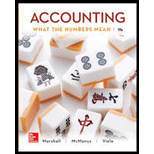
Concept explainers
Concept Introduction:
Direct labor rate variance-
Direct labor rate variance is the variance which measures the difference between standard rate and actual hourly rate paid.. If actual rate paid is more than the standard rate then the variance is unfavorable and if actual rate paid is less than the standard rate then the variance is favorable. It is calculated as follows-
Direct labor efficiency variance-
Direct labor efficiency variance is the variance which measures the difference between standard hours allowed and actual hours taken for the work done. If actual hours are more than the standard hours allowed then the variance is unfavorable and if actual hours are less than the standard hours allowed then the variance is favorable. It is calculated as follows-
To compute:
Direct labor rate variance and direct labor efficiency variance
Want to see the full answer?
Check out a sample textbook solution
Chapter 15 Solutions
Accounting: What the Numbers Mean
- Drake, Inc. produces a product that has a variable cost of $8.00 per unit. The company's fixed costs are $75,000. The product is sold for $12.50 per unit and the company desires to earn a target profit of $45,000. What is the amount of sales that will be necessary to earn the desired profit? Need answerarrow_forwardI need assistance with this financial accounting question using appropriate principles.arrow_forwardCan you explain this financial accounting question using accurate calculation methods?arrow_forward

 AccountingAccountingISBN:9781337272094Author:WARREN, Carl S., Reeve, James M., Duchac, Jonathan E.Publisher:Cengage Learning,
AccountingAccountingISBN:9781337272094Author:WARREN, Carl S., Reeve, James M., Duchac, Jonathan E.Publisher:Cengage Learning, Accounting Information SystemsAccountingISBN:9781337619202Author:Hall, James A.Publisher:Cengage Learning,
Accounting Information SystemsAccountingISBN:9781337619202Author:Hall, James A.Publisher:Cengage Learning, Horngren's Cost Accounting: A Managerial Emphasis...AccountingISBN:9780134475585Author:Srikant M. Datar, Madhav V. RajanPublisher:PEARSON
Horngren's Cost Accounting: A Managerial Emphasis...AccountingISBN:9780134475585Author:Srikant M. Datar, Madhav V. RajanPublisher:PEARSON Intermediate AccountingAccountingISBN:9781259722660Author:J. David Spiceland, Mark W. Nelson, Wayne M ThomasPublisher:McGraw-Hill Education
Intermediate AccountingAccountingISBN:9781259722660Author:J. David Spiceland, Mark W. Nelson, Wayne M ThomasPublisher:McGraw-Hill Education Financial and Managerial AccountingAccountingISBN:9781259726705Author:John J Wild, Ken W. Shaw, Barbara Chiappetta Fundamental Accounting PrinciplesPublisher:McGraw-Hill Education
Financial and Managerial AccountingAccountingISBN:9781259726705Author:John J Wild, Ken W. Shaw, Barbara Chiappetta Fundamental Accounting PrinciplesPublisher:McGraw-Hill Education





